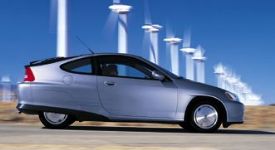
2006 Honda Civic Hybrid
Imagine a special sticker that let you use those high-occupancy vehicle lanes, zipping past stop-and-go rush hour traffic, blissfully alone in your car. If you live in California and were one of 85,000 lucky hybrid owners, you know exactly what I'm talking about.
In 2005, California decided to open HOV lanes to a limited number of exceptionally low-emission vehicles, as an incentive to buyers to trade in their old cars for a Toyota Prius (any year), Honda Civic Hybrid (any year), or old Honda Insight (1999-2006).
California set the number of stickers at 75,000, and the stickers were all applied for in less than a year. Another allotment of 10,000 at the start of 2007 was similarly snapped up within months. Though the process was cumbersome, they cost only $8 each.
How much is a smoother commute worth?
Now Audatex, a company that automates processing for insurance claims, has studied how much value a California Clean Air Vehicle sticker adds to a used hybrid.
The company did the study to investigate whether vehicles that were declared a total loss after an accident should be given a higher value if they had a sticker--especially since California will issue a new sticker to the owner of such a totaled vehicle.
The company focused in on the 2005 and 2006 Honda Civic Hybrid and their gasoline equivalents. In California, the average used price of a Civic Hybrid was 7 percent higher than the average state--while the gasoline version prices were identical.
That translated into a premium of $1,203 for the 2005 Civic Hybrid and $1,509 for the newer 2006 model. Anecdotal evidence from the height of last year's gasoline-price spike indicated that the stickers added as much as $4,000 or $5,000 to the value of a used Toyota Prius, but this is the first study to look at actual sale price data.
Not just hybrids
Other categories of cars were eligible for the stickers too, incidentally, including whatever portion of the 2,000 or so Honda Civic GX natural-gas vehicles produced each year that was sold in California.
Highway-capable electric cars qualified too, but owners of the 2009 Tesla Roadster didn't receive their cars until well after all the stickers had been assigned.
And the price differential will vanish on January 1, 2011. That's when the stickers expire; thus far, California legislators haven't given any indication that they plan to renew the program.
Such breaks are one of many different incentives and tax breaks that encourage purchase of fuel-efficient hybrids. New Mexico, for example, exempts new hybrids with a combined fuel economy rating of at lesat 27.5 miles per gallon from the state's 3 percent vehicle excise tax.
In the Washington, DC, area, Virginia lets hybrid drivers with special license plates use its high-occupancy vehicle lanes even if they are driving alone. Another such perk, free parking in the city of Los Angeles, ended on March 1 for budgetary reasons.
Audatex, by the way, is also the author of a study that looked at the repair-cost differential between hybrids and other cars. Their study found hybrid repairs were pricier until recently, but had normalized by 2008.

2001 Honda Insight
[Audatex Directions, pp. 12-13]













